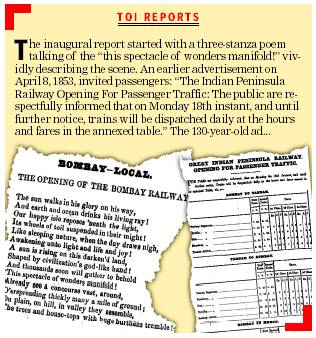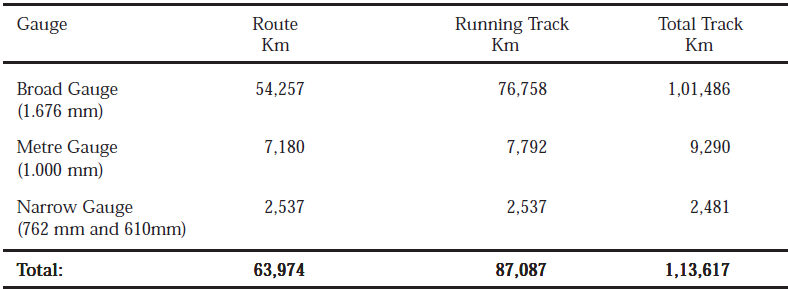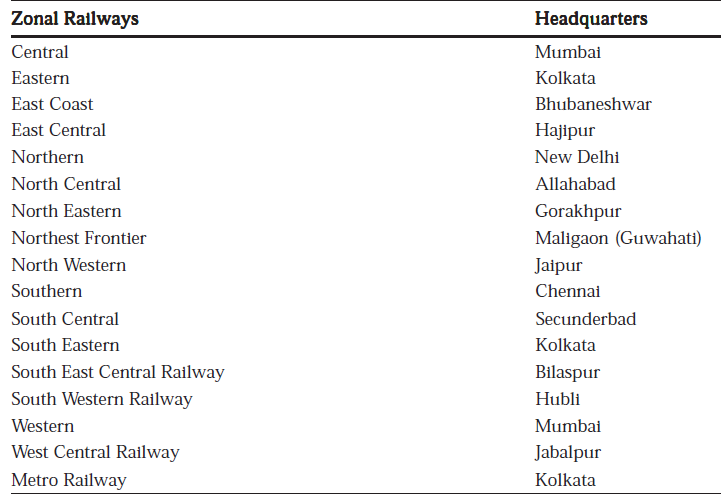Railways, India: 2 (ministry data)




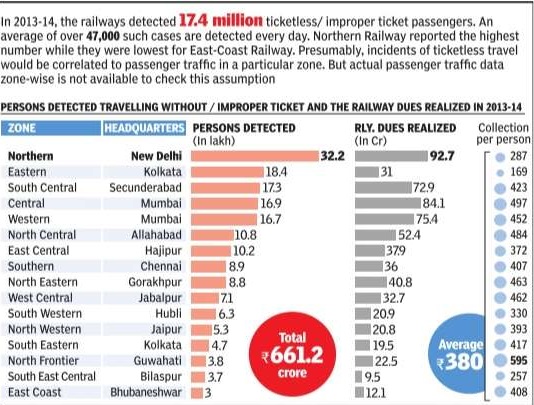
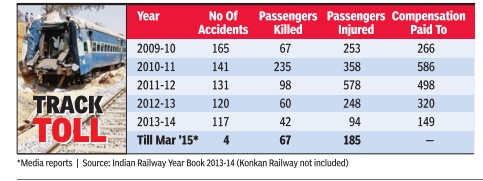

This article has been sourced from an authoritative, official readers who wish to update or add further details can do so on a ‘Part II’ of this article. |
The primary source of this article
INDIA 2012
A REFERENCE ANNUAL
Compiled by
RESEARCH, REFERENCE AND TRAINING DIVISION
PUBLICATIONS DIVISION
MINISTRY OF INFORMATION AND BROADCASTING
GOVERNMENT OF INDIA
India’s 1st train: When Sahib, Sindh & Sultan blew steam
The Times of India APRIL 18 | 1853
India’s first passenger train was flagged off on its maiden run between Bori Bunder (later Victoria Terminus, now Chhatrapati Shiva ji Terminus) and Thane — a distance of 21 miles covered in 57 minutes, at 3.35pm on April 16, 1853. Drawn by three engines, Sahib, Sindh and Sultan, the train lurched forward amid fanfare and celebration.
TOI exulted: “Nothing could’ve been more magnificent than the train of 20 enormous carriages with their three stupendous engines, all spick and span new, with the most perfect forms engineering could suggest, and the most beautiful tints taste could impart, occupying a line from first to last on close to four hundred feet.”
The inaugural report noted with pride, “The 16th of April 1853 was, and would long continue to be one of the most memorable days, if not the most memorable day, in the annals of British India.”
“This was not the triumph of nation over nation, of race over race, of man over his fellow man. It was the triumph of mind of matter, of patience and perseverance,” the report quoted a British official at the inaugural function.
Earlier reports and advertisements in the paper had added to the rapidly building excitement over the train’s maiden run. An advertisement on April 8, 1853 quoted traffic manager Roche saying this to prospective riders. “The public are respectfully informed that on Monday, and until further notice, trains will be dispatched daily at the hours and fares named in the annexed table. First class day tickets for the double journey only on the day of issue will be given between Bombay, Tannah and Mahim at three-fourths of the ordinary fare.”
TRACK SETTING | Plans for a rail system in India were first put forward in 1832 and the Madras Presidency got the first experimental railway line.
In 1844, governor general Hardinge allowed private entrepreneurs to set up a rail system if they guaranteed an annual return of up to 5% in the initial years. The first passenger train was the product of efforts of Parsi businessman Sir Jamsetjee Jejeebhoy and Nana Shankarsheth, who formed the Indian Railway Association. This eventually merged into the Great Indian Peninsula Railway. Jejeebhoy and Shankarseth were the only two Indian directors in the 10-member board. TNN
Milestones in the history of Indian Railways
The Times of India Feb 27 2015
Rail recall
Conditioned air
First extensive air conditioning system was used to cool first class coaches of the most famous train of the British Raj. In 1934 Frontier Mail became India's first train to have air conditioning. Large blocks of ice were placed beneath the car's containers. A battery operated fan would blow the air that was then made to enter the insulated coach through vents. The ice was replenished at major halts to keep the system running.The first fully AC train was introduced between Howrah and Delhi in 1956.
Inspirational train
Indian railways were one of three technological breakthroughs of the late 19th Century that inspired Jules Verne to write his famous adventure novel `Around the World in 80 days'. The other two were first transcontinental railroad in America and the Suez Canal.
Long and short of it
Odisha's Ib railway station holds the record of having the shortest name Andhra's Venkatanarasimharajuvaripeta is the longest name of any railway station
Spanning India
Vivek Express between Kanyakumari and Dibrugarh has the longest run. The 4,286 km journey is longer than the 3,715 km route of the Himsagar Express which held the crown of running on India's longest route.
Last on the lane
Baramulla is the last station of northernmost railways.Naliya is the westernmost, Kanyakumari southernmost and Ledo is easternmost
Railways
The Railways in India provide the principal mode of transportation for freight and passengers. It brings together people from the farthest corners of the country and makes possible the conduct of business, sight seeing, pilgrimage and education. The Indian Railways have been a great integrating force during the last more than 155 years. It has bound the economic life of the country and helped in accelerating the development of industry and agriculture. From a very modest beginning in 1853, when the first train steamed off from Mumbai to Thane, a distance of 34 km, Indian Railways have grown into a vast network of 7,030 stations spread over a route length of 63,974 km with a fleet of 8,593 locomotives, 51,030 passenger service vehicles, 6,505 other coaching vehicles and 2,19,931 wagons as on 31st March, 2010. The growth of Indian Railways in the 150 years of its existence is thus phenomenal. It has played a vital role in the economic, industrial and social development of the country. The network runs multigauge operations extending over 63,974 route kilometres. The gauge-wise route and track lengths of the system as on 31st March, 2010 are as under:
Gauge Route Running Track Total Track
About 30 per cent of the route kilometre, 41 per cent of running track kilometre and 43 per cent of total track kilometre is electrified. The network is divided into 17 Zones. Divisions are the basic operating units. The 17 zones and their respective
headquarters are given below :
Cooperation between public and Railway administration is secured through various committees including Zonal Railway Users' Consultative Committees and Divisional Railway Users'Consultative Committees. The rolling stock fleet of Indian Railways in service as on 31st March 2009 comprised 42 Steam, 5,022 diesel and 3,825 electric locomotives. Currently, the Railways are in the process of inducting new designs of fuel-efficient locomotives of higher horse power, high-speed coaches and modern bogies for freight traffic. Modern signalling like panel inter-locking, route relay inter-locking, centralized traffic control, automatic signalling and multiaspect colour light signalling are being progressively introduced. The Indian Railways have made impressive progress regarding indigenous production of rolling stock and variety of other equipment over the years and is now self-sufficient in most of the items.
The main objectives of railways planning have been to develop the transport infrastructure to carry the projected quantum of traffic and meet the developmental needs of the economy. Since the inception of the planned era in 1950-51, Indian Railways have implemented nine five-year plans, apart from annual plans in some years. During the Plans, emphasis was laid on a comprehensive programme of system modernization. With capacity being stretched to the full, investment of costeffective technological changes become inescapable in order to meet the everincreasing demand for rail transport. Along with the major thrust directed towards rehabilitation of assets, technological changes and upgradation of standards were initiated in important areas of track, locomotives, passenger coaches, wagon-bogie designs, signaling and telecommunication. Progress of Railway traffic and inputs is shown in table 25.1.
2007-10: Discrepencies in railways’ net revenue surplus
Mahendra Kumar Singh TNN The Times of India, Aug 6, 2011
Former rail minister Lalu Prasad’s turnaround of railways from a loss-making to a profit venture was more of a cosmetic exercise, reveals the government auditor’s report.
According to CAG, it was the new practice of issuing a “statement of cash and investible surplus” that helped Lalu project a rosy picture. The auditor has said the innovation helped the former railway minister project a “cash and investible surplus” of Rs 88,669 crore from 2004-2005 to 2008-2009 when the net revenue surplus was only Rs 34,506 crore.
Railways calculated the net revenue surplus after meeting all expenditures, including payment of dividend and appropriation to depreciation reserve fund (DRF) used for renewal or replacement of existing assets.
The ‘cash surplus’ in new presentation indicated the sum generated by railways from operations and other activities, including the interest on fund balance. It shows the money available for paying dividend, appropriation to DRF and other funds for investment. The “investible surplus” was expected to indicate the resources generated annually for capital expenditure after fulfilling the dividend liability.
CAG endorsed the white paper presented by Lalu’s successor Mamata Banerjee in Parliament, which questioned the turnaround story, and pointed out, “this was not accounting change but more in nature of presentation of financial projections from different perspective.”
However, the railways’ finances became worse during Mamata’s tenure as the net revenue surplus saw a sharp decline from Rs 13,431 crore in 2007-08 to Rs 4,457 crore in 2008-09 to a paltry Rs 75 lakh in 2009-10.
Though, CAG mentioned that the poor state of affairs was due to the implementation of the sixth pay commission, which was Rs 37,472 crore during 2008-10, it also blamed the lower growth rate in traffic receipts and increase in working expense.
“During 2009-10, the gross traffic receipt increased by 9%, whereas ordinary working expense grew by 21% over the previous year,” the report cited. Railways efficiency measured by operating ratio (percentage of working expenses to traffic earnings) declined to 95.28% in 2009-10 from 90.46% achieved in the previous year.
Out of 16 zonal railways, eight had operating ratio of more than 100%, which means that their working expenditure was more than traffic earnings. The report reflects that the performance of the railways declined marginally during the last leg of Lalu’s tenure and further worsened when Mamata was at its helm.
Public Sector Undertakings
There are thirteen undertakings under the administrative control of the Ministry of Railways, viz. (i) Rail India Technical & Economic Services Limited (RITES); (ii) Indian Railway Construction (IRCON) International Limited; (iii) Indian Railway Finance Corporation Limited (IRFC); (iv) Container Corporation of India Limited (CONCOR); (v) Konkan Railway Corporation Limited (KRCL). (vi) Mumbai Rail Vikas Nigam Ltd. (MRVNL); (vii) Indian Railway Catering and Tourism Corporation Ltd. (IRCTC); (viii) Railtel Corporation of India Ltd. (Rail Tel); (ix) Rail Vikas Nigam Ltd. (RVNL), (x) Dedicated freight corridor corporation of India Limited (DFCCIL) (xi) Bharat Wagon and Engineering Co. Ltd. (BWEL). (xii) Burn standard Company Limited (BSCL) & (xiii) Braithwaite and Company Limited (BCL).
Rolling Stock
Over the years, Indian Railways has not only achieved self-sufficiency in production of rolling stock in the country but also supplied rolling stock to other countries and non-railway customers. Indian Railways are now manufacturing 4500 HP, state of the art, AC-DC, micro processor control, fuel efficient diesel locomotives at Diesel Locomotive Works (DLW), Varanasi and 6000 HP, three phase electric locomotives at Chittaranjan Locomotive Works (CLW), Chittaranjan. In 2009-10, DLW manufactured 258 locomotives which is its best ever performance. DLW also rolled out 110 HHP EMD type locomotives which is again a record. CLW manufactured 220 electric locomotives which includes 60 HHP locomotives.
Indian Railways are manufacturing LHB design high-speed light weight coaches at Rail Coach Factory (RCF), Kapurthala. During 2009-2010, RCF achieved a record production of 1568 coaches. RCF rolled out first prototype air conditioned Double Decker coach in March 2010. RCF also produced 9 stainless steel rakes and 2 fully air-conditioned LHB rakes for running on Duronto trains. Integral Coach Factory (ICF), Chennai produced 1433 coaches including first High Speed Self- Propelled Accident Relief train and four rakes of DMUs with toilet facility. Rail Wheel Factory (RWF), Bangalore manufactured 187460 wheels, 65302 axles and 55940 wheel sets during 2009-10. Diesel loco Modernization Works (DMW), Patiala rebuilt 112 locomotives during 2009-10 against the earlier record rebuilding of 108 locomotives achieved in 2008-09.
Research and Development
The Research, Design and Standards Organization (RDSO) at Lucknow is the R&D wing of Indian Railways. It functions as a consultant to the Indian Railways in technical matters. It also provides consultancy to other organizations connected with railway manufacture and design.
Commission of Railway Safety
The Commission of Railway Safety deals with matters pertaining to safety of rail travel and train operation and for this purpose perform statutory functions as laid down in the Railways Act, 1989 and the rules framed thereunder.
Formerly called the Railway Inspectorate, it functioned under the control of the Railway Board till may 1941 when the Inspectorate was separated from the control of Railway Board to secure its independence from the authority administering the Railways. This separation was carried out pursuant to the recommendations of a committee called the 'Pacific Locomotive Committee', which was endorsed by the Central Legislature.
After its separation, Inspectorate was attached to the Air Wing and placed under Department of Communications. It came under the administrative control of the Ministry of Civil Aviation and Tourism in May 1967, subsequently redesignated as the Ministry of Civil Aviation.
The main task of the Commission is to direct, advice and caution and railway executive through its inspectional, investigatory and advisory functions and thereby assist them in ensuring that all stipulated measures are taken in regard to the soundness of rail construction and safety in train operation.
The commission is headed by the Chief Commissioner of Railway Safety who is the Principal Technical Adviser to the Government of India in all matters pertaining to Commission of Railway Safety. The headquarters of the Commission are located at Lucknow. The Chief Commissioner directs the technical activities of the Commission and issues instruction for the guidance of Commissioner of Railway
Safety in respect of holding statutory inquires into serious railway accidents, inspection of new lines including electrification of existing lines prior to their opening for public carriage of passengers and sanction for running of new locomotives/ rolling stock. The Commission has 9 circle offices, viz., two with headquarters at Mumbai, 3 with headquarters at Kolkata and one each with headquarters at Bangalore, New Delhi, Lucknow and Secunderabad. Each circle office is under the charge of a Commissioner.
After enactment of the Metro Railways (Amendment) Bill 2009 which provides for extension of the Metro Railway Construction of Works) Act, 1978 and the Delhi Metro Railway (Operation and Maintenance) Act, 2002 (which after amendment was renamed as the Metro Railway (Operation and Maintenance) Act, 2002) to National Capital Region, Metropolitan cities and Metropolitan area, the Commission of Railway Safety has been entrusted with functions and duties in respect of Metro Railways under the purview of the said Act, similar to its functions and duties as it has been performing under the Railways Act, 1989 in respect of Indian Railways. Accordingly, Commissioner of Railway Safety, southern Circle, Bangalore and Commissioner of Railway Safety, western Circle, Mumbai have been appointed as Commissioner of Metro Railway Safety for Bangalore Metro Railways and Mumbai Metro Railways respectively.
Railway Finance
Since 1924-25, railway finances remain separated from general revenues. They have their own funds and accounts and the Railway Budget is presented separately to Parliament. However, the Railways contribute to the general revenue a dividend on the capital invested. Quantum of contribution is reviewed periodically by a Parliamentary Convention Committee.
Passenger Traffic
Passengers originating had risen from 1,284 million in 1950-51 to 7,246 million in 2009-2010 and passenger kilometre from 66.52 billion in 1950-51 to 903 billion in 2009-2010. Despite constraint of resources, the Railways have been able to cope with increasing demand of passenger traffic. Railways are the premier mode of passenger transport both for long distance and suburban traffic.
Freight Traffic
Rapid progress in industrial and agricultural sectors has generated a higher level of demand for rail transport, particularly in core sectors like coal, iron and steel ores, petroleum products and essential commodities such as foodgrains, fertilizers, cement, sugar, salt, edible oils etc. Revenue freight traffic increased from 73.2 million tonnes in 1950-51 to 887.79 million tonnes in 2009-10. Transport effort measured in terms of net tonne kilometres (NTkm) increased from 38 billion in 1950-51 to 601 billion in 2009-2010. Some of the measures taken for improvement are: (i) line capacity augmentation on certain critical sectors and modernization of signalling system; (ii) measures such as unit train operation for bulk commodities like coal; (iii) increase in roller-bearing equipped wagons; (iv) increase in trailing loads to 4,500 tonnes; (v) operation 'UNI-GAUGE’ on Indian Railways; (vi) strengthening the track structure by providing heavier and stronger rails and concrete sleepers; and (vii) production of prototype electric locomotive of 5000 HP for freight operation by Chittaranjan Locomotive Works.
2013-15
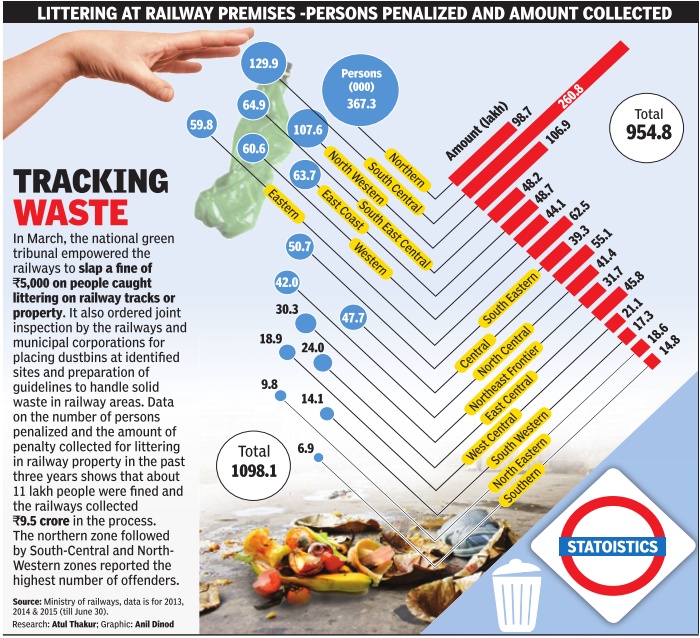
Railway accidents
40% of rail mishaps are at level crossings
The Times of India, Aug 25 2015
40% of rail mishaps are at level crossings
Mahendra Singh
Mishaps at level crossings are the biggest killers, accounting for 40% of train accidents and 66% of fatalities, reflecting the cashstrapped railways' failure to eliminate these crossings by building road-over bridges and road-under-bridges.
The latest data shows that there are 29,487 level crossings, of which around 10,440 are unmanned. Between 2008 and 2015, only 1,344 manned and 7,650 unmanned crossings have been eliminated. In 2015-16, railways targets to get rid of 820 unmanned and 205 manned crossings.
Around 18 accidents on unmanned crossing and three on manned have been reported since April 2015.
2016

Dual Freight Policy struck down
The Hindu, June 29, 2016
Dual freight policy for iron ore goes
In a bid to boost freight traffic volumes, the Indian Railways has abolished its dual freight policy for carrying iron ore, a long-pending demand from industry players.
According to a 2008 policy, the tariff for transportation of iron ore to ports for the purpose of exports is three times the rate charged for transporting the same commodity for domestic use in steel and cement industries.
“The dual pricing policy for iron ore transportation was very complicated. From now on, whether you move the iron ore to the plant or to the ports for exports, we will be charging the same,” Railway Board Member (Traffic) Mohammed Jamshed said on Wednesday. Cheering the move, industry representatives said the freight rationalisation will help both Railways and the iron ore sector. “It is a long-overdue move. We had urged the government to bring parity in rates of iron ore transportation irrespective of point of origin and destination,” said Basant Poddar, vice president at Federation of Indian Mineral Industries. A Comptroller and Auditor General (CAG) report tabled in Parliament last year had pointed out that the freight business suffered losses of around Rs 29,000 crore in 2008-13 due to the dual pricing system for transporting iron ore. It had found that iron ore was carried at lower domestic rates but was diverted for exports resulting in huge losses to the exchequer.
Railway budgeting to end in 2017
The Times of India, Aug 13, 2016
Mahendra Singh
There will be no separate railway budget from financial year 2017-18, putting an end to a practice that started in 1924, with the finance ministry agreeing to the proposal to merge the transporter's annual exercise with the general budget. Government sources told that the finance ministry has constituted a five-member committee of officers to work out the modalities for the exercise, which will end the annual budget speech+ , often followed closely for project announcements, by the railway minister. The move is significant as in recent years, particularly since coalition governments post-1996, political heavyweights have used the railway budget to hand out goodies and for their own image building. With the railway portfolio often held by regional biggies, the budget reflected political priorities of the incumbent. The railway bureaucracy has also dug in its heels in the past.
Railway minister Suresh Prabhu+ 's readiness to give up the limelight is a break from the past as BJP seems in a position to dump the railway budget as its solid majority in Lok Sabha enabled it to retain the portfolio rather than handing it to an ally.
Once the rail budget is merged with the general budget, railways will be like any other government department that receives budgetary support but comes under the finance ministry's oversight as far as spending and earnings are concerned. Once the overall funds are allocated, railways will then segregate them for various purposes with sources indicating that the model will be similar to the one for the postal department.


